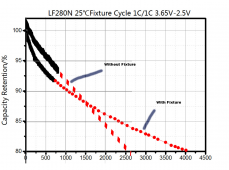Hmm, looking at LF304 datasheet - aluminium plates are 8mm (vs 10mm for 280K), EOL expansion force under 30kN(vs 280k 50kN)
Dimensions are pretty much the same between 280 and 304...
But here is the weird discrepancy:
View attachment 109567
Leakage force is
15kN (LF 304)
vs 100kN (LF280K)
Any clues?
I can bring some clarity in that aspect, being survivor (with damage) of the 100-120-135-152Ah casing.
Same casing used for 100 and 152Ah cells, what can go wrong...??
Exactly this.
When you put more sheets in the same casing, lots of things change, like less force..
Also, the 152Ah could not be used free standing, they expand (bloat) just too many sheets in a small container.
List of (possible) problems continues.
With higher capacity cells, and most of the time higher capacity used for charge and discharge, your error margin is reduced.
Where you could use a bolt at 20A, with 40A you already need a stud, increased strength to the terminal using loctite or similar.
At 50 or 60A, laser welded studs or busbars get mandatory.
Not even talking about additional safety like clamping here...
@Browneye , I totally agree that you should make the setup as safe as possible and stay far from the top and low of "possible".
Usually the "possible" is under laboratory optimal conditions, and where in "the west" often 10% is reduced for safety, in "the east" 10% is added for better sales

How to really know the clamping force?
Or the force pressing the busbar on the terminal?
Not for us mortals without expensive equipment, and even then, there will be variations in each setup.
Robots and production hall, different from DIY at home.
Just a tiny bit ?
Usually there is the "China margine" of 1/3.
150A breaker, use on max 100A (and even that, not continuous)
3000W inverter, don't go beyond 2000W (except some peaks)
List goes on.
If you would use the 280 or 304Ah to -200Ah, staying from the top and bottom..
Use capacity reasonable for the setup (not laser welded? Stay under 40A!)
Compression is one of the least worries.
And as it's almost impossible to measure...
(For DYI) a "snug fit" is good enough.
You can put force on the side of the casing, as the cells bend inward when you received them (a bit look like this )( ... Binoculars glass) all your force is on the thin aluminium side walls.
When they start to expand, going from )( to || and eventually (), the snug fit will provide all force automatically.
One problem will be with too much sheets in a cell, that allowing any space for () and afterwards returning to ||, can/ will give internal shorts, self discharge and all kinds of nastyness.
We know the 280 are stable.
Don't know much about the 304 or the 320 in the same housing.
We do know that the stable 100 and 120ah suddenly became a probelm with 152.
Just be careful buying higher capacity in the same casing.
It is known to give problems in the past.










